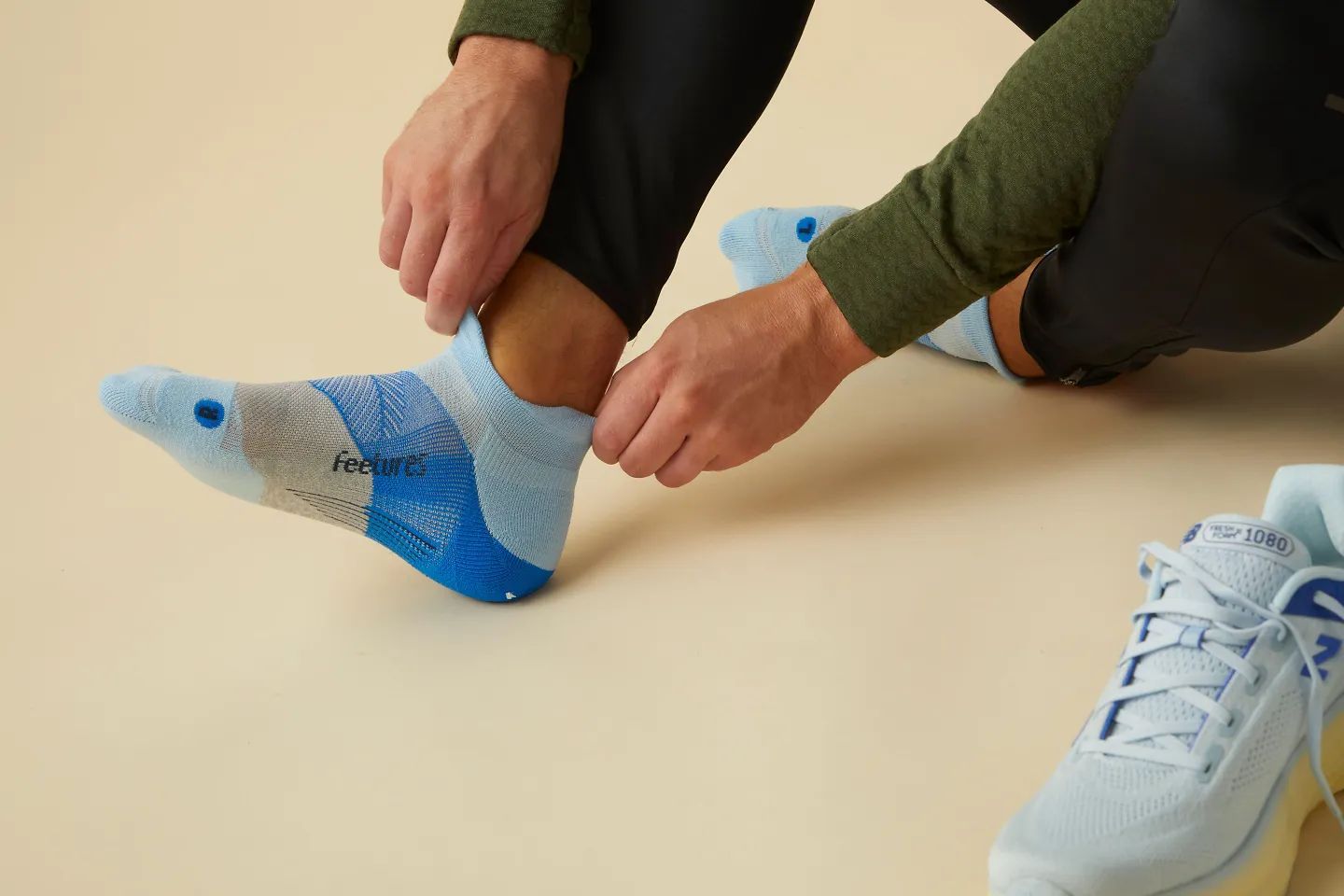- Vendry
- Posts
- Vol 34. Insights from Feetures CMO Joe Gaither
Vol 34. Insights from Feetures CMO Joe Gaither
Feetures CMO Joe Gaither shares insights on category leadership, retail partnerships, and scaling DTC performance.

Case Studied Experts
Meet Joe Gaither
Each week, we sit down with a marketing leader to learn more about their career, insights, and accomplishments. This week, that marketing leader is Joe Gaither, CMO of Feetures.
Joe has spent his career helping transform a niche family brand into a performance leader with deep retail roots and a rapidly scaling DTC engine. He didn’t study marketing or even plan on joining the family business. But he made his way to the C-suite through learning by doing, trusting taste, and building a category, one relationship at a time.
Here are the need-to-knows about Joe:
Joe helped grow Feetures from a small family-owned startup into the #1 brand in running specialty (aka one of the most competitive retail channels in the U.S.).
He led the company’s shift into direct-to-consumer, pushing Feetures to build its DTC engine years before COVID made it a lifeline.
He built Feetures’ in-house creative engine for Meta advertising, which drove performance from +20% YoY to +40% essentially overnight.
From history major to field sales

Before he became a marketer, Joe was a history student at the University of North Carolina. “A student with an unknown future,” as he puts it.
What changed his trajectory wasn’t an internship or even a job application. It was his dad’s decision to start over and launch Feetures after decades of working in a different family business. When Joe graduated, he jumped in to help wherever he was needed.
That meant Joe’s first role was knocking on doors, meeting customers, and talking about socks. “I started out in a sales role, visiting all our existing customers. We were mainly doing business with specialty retailers so I traveled and got to know them and how our products were meaningful to them.”
It was trial by fire but the experience cemented Joe’s earliest marketing belief: customer service is a marketing function.
“If you take care of your customers and you listen to them and improve your products because of their feedback… that’s the best form of marketing you can do.”
In those early days, Feetures wasn’t just selling socks. They were trying to convince the industry that socks mattered, that they weren’t an afterthought, and that performance gear started at the foot. Eventually, the category started to adopt that sentiment.
For Joe, this early exposure to retailers, staff, and runners shaped his point of view more than any marketing course or textbook could have.
Finding marketing
Joe didn’t ask to run marketing at Feetures but his fit with the role showed up organically.
He’d come up with the name “Feetures”, he’d gravitated toward packaging, and he had strong instincts for design. Eventually, his brother—who had been juggling product and marketing—realized the company needed dedicated leadership and Joe was already doing a lot of the legwork.
“He offered me the opportunity to build out a marketing function and I happily jumped at that,” Joe said.
There was no blueprint, no previous team structure, and no formal training. But Joe did have one huge advantage: an early mentor in Feetures’ original business partner, a former Clorox marketer and Stanford MBA, who the brand regularly partnered with.

“Anytime we had needs for marketing campaigns or packaging, we worked with his company. So we were going through these processes and I just observed everything from ideating to brainstorming to finalizing concepts. He was a great asset for me to further my understanding of marketing.”
Building the hard way

Feetures has a classic, old-school growth story. There were no shortcuts, no instant virality, no DTC boom out of the gate. “When we started in 2002, there was no direct-to-consumer business. That wasn’t an option,” Joe said.
Because of that, the company went the hard route and sold to small, independent retailers. But they had some benefits. These were spaces with high trust among customers and staffers who spoke with one another regularly. And Feetures ended up becoming the go-to sock brand these stores recommended.
Today, Feetures owns roughly 50% of the run specialty market—a dominance that took two decades of relationship-building to earn.
Feetures earned that portion of the pie through a playbook based on product quality and deep partnerships. They give away hundreds of thousands of dollars in product samples so store staff could let customers experience the product firsthand. They matched every promo their retailers run. And they seeded local run clubs and Couch to 5K programs.
The DTC push
Joe knew something needed to change within Feetures when Bombas exploded online. He recognized early that consumers were forming direct relationships with brands and he wanted Feetures to build that muscle too.
“They’re one of the largest household names in our category,” he said. “But I saw their rise as a signal, not a threat. We wanted to tell our story as successfully as they were telling theirs.”

The challenge? Feetures was a family business built on B2B. DTC required new systems, creative talent, and a mindset shift. Not everyone was ready to move but Joe advocated and by 2015–2016, the brand had leaned in and gotten serious about it.
“We had developed DTC by the time the pandemic hit… That was great because when retail shut down and direct-to-consumer sales took off, we already had our foundation built.”
Today, DTC (including Amazon) is roughly half the business.
A Standout Campaign
Of everything Joe has built, one of the initiatives he’s most proud of is bringing Feetures’ Meta creative in-house.
“Before the trend really took off among consumer brands, we set up an internal creative operations team and a digital marketing team to run everything. It’s been a game-changer for us. We took our direct-to-consumer business from up 20% year-over-year to up 40% overnight. And we’ve sustained that growth because of the volume of creative we’re pumping out.”
The idea came when Joe noticed the need to have more brand-aligned creative, faster iterations, and more control. He found that though his agency partners were helpful, they didn’t always nail down exactly what the brand was looking for.
So, Joe and the team mapped out roles, restructured responsibilities, and set a goal of 100+ new ads every month. Within weeks, they saw their first breakout winner. Then another. Then many.
“It galvanized everybody. They were part of the concepting, the creative, and watching the success. And seeing all that made everyone want to keep going.”
Now, that creative engine is the backbone of Feetures’ growth and the team consistently produces over 100 ads per month and you can check out their live ads in the Meta Ads Library.
The Offer:
Save 20+ hours and let us run your agency RFP for free.
We’ve running agency RFPs for over 1,000 brands and the feedback is always the same… marketers hate wasting time running agency searches themselves.
Whether it’s working with big brands like The Clorox Company or fast growing DTC teams like Thrive Market or Magic Spoon, Vendry saves you time while bringing you agencies that deliver exceptional performance across Paid Social, PR, PPC, SEO and more.
With only 2 months left to hire an agency for 2026, schedule a call with our team and we’ll bring you 3 top performing agencies, handpicked for your needs, 100% free.
Advice and Takeaways
1) Treat customer service like a marketing channel.
From the brand’s earliest days, Feetures responded to feedback, iterated their products, and treated retailers like partners. Those actions sparked powerful growth for the brand and Joe made sure to prioritize them as they scaled. Listening became a competitive advantage that informed product decisions, strengthened retail loyalty, and shaped marketing narratives.
Consider how you can get closer to the people who buy your product. Maybe that means shadowing customer support, visiting stores, or reading every review. Whatever form it takes, try a new way of gathering information on what people love (and don’t love) so you can market your product more effectively.
2) Focus before you scale.
Feetures started off focusing on the run specialty category and becoming the leader in that space. They didn’t expand into new categories until it had a firm lead in run specialty and in doing so, they built a moat their competitors struggled to touch. As Joe puts it, “trying to dominate one space can actually help you grow better and faster.”
If you’re growing a brand, consider tightening your aperture. Identify the one community, channel, or customer segment where winning could unlock everything else. Depth can create defensibility so start by going deep and expand later.
3) Invest in change when it’s needed.
Bringing Feetures’ Meta creative in-house was a significant overhaul. It required new roles, new processes, and a willingness to experiment at high volume. But ultimately, that move gave Feetures a permanent competitive advantage, allowing the brand to move faster and test more aggressively.
Take note of your marketing team’s strongest and weakest muscles. For the areas that need some help, what could you do to strengthen them? For the areas that are already strong, what are you doing right? Those insights can inform meaningful ways to iterate and experiment with change.
Think long-term: What could help make your campaigns more successful over time? The right agency partner. And Vendry can help you meet yours, for free. Get started.